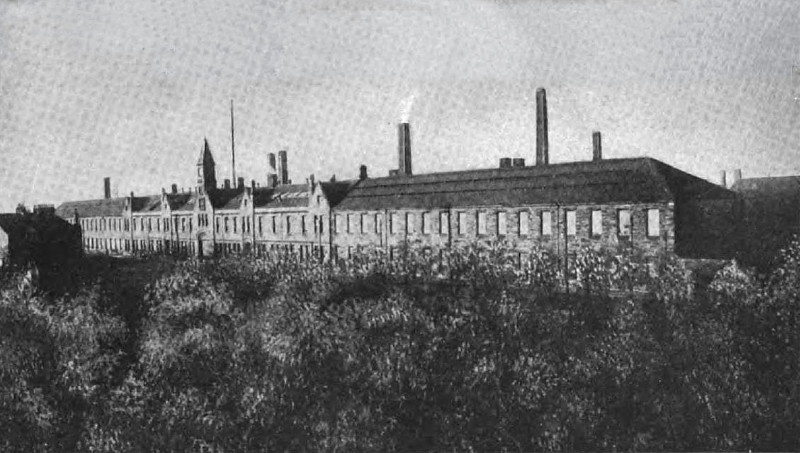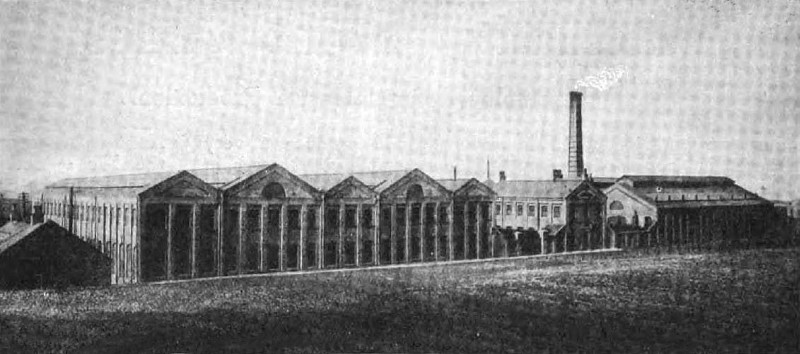
|
|

|
|
1921 Factory View
|
|
1921 Engineering Department
|
Founded in 1759, the Carron Co., practically the pioneers of the iron industry in Scotland, have played a most important part in the engineering history of this country. The company owes its inception largely to Dr. John Roebuck, of Sheffield, who was an eminent scientist and mineralogist of his time, and the discoverer of important improvements relating to the production of iron. Dr. Roebuck, when a partner with Samuel Garbett as chemical manufacturers at Prestonpans, near Edinburgh, was strongly impressed with the mineral wealth then lying unheeded between the Forth and the Clyde. He communicated his ideas to Mr. Cadell, of Cockenzie, who was, at that time, keenly interested in the development of Scotch industries.
The original proposal was to start an iron foundry in the neighbourhood of Cockenzie, but eventually the site was not regarded as the best for the purpose, and after due consideration a position was selected on the north bank of the River Carron, operations in connection with the erection of the foundry being started towards the end of the year 1759. The first day of January, 1760, was a memorable one in the history of the Carron Co., for on that day the work of iron-making at Carron was actually commenced.
It was the fortune of the Carron Co. to come into being during a somewhat belligerent period in the country’s history, and it is not surprising, therefore, to find that some of the earliest activities of the company were devoted to the manufacture of munitions of war, including cannon, and, in particular, small naval guns. Under the name of “Carronades”, these guns were famous in their day, and played an important part in the French wars that took place at the end of the eighteenth and the beginning of the nineteenth centuries; subsequently, however, the alterations that were introduced into the modern artillery rendered it a special industry which the Carron Co. did not consider it advisable to follow. It is interesting to note that Major Shrapnel carried out, in the works of the Carron Co., his experiments in perfecting his invention, the "Shrapnel Shell". At the time of the last Boer War, and, of course, during the recent conflict, the manufacture of war material was resumed for the time being in the Carron workshops.
The present day products of the Carron works include ships’ fittings of every description, haulage gears, drop forgings, brass and gunmetal castings, fly wheels and stamped steel forgings, fire grates of all descriptions, as well as a series of machine tools for wood-working. A Royal Charter of Incorporation was granted to the company by his Majesty George III, in the year 1773, and at the present time, the company are iron founders to his Majesty the King by Royal appointment.
Some of the most notable engineers in the history of this country have been associated with the Carron Co. from time to time, including James Watt, the inventor of the steam engine, who became acquainted with, and was befriended by, Dr. Roebuck. The first castings for the Watt steam engines were made in the Carron foundries, and the engine was erected at Kinneil House, the residence of Dr. Roebuck.
One of the first steamships built in the United Kingdom was constructed on the River Carron in 1789, by William Symington, and the engines for this vessel were made at the Carron works. It is interesting to record that the cost of these engines was £363 10s. 6d.
The Carron blast furnaces have the largest capacity of any works in Scotland, and are equipped with plant of particularly modern design. A well-equipped chemical laboratory with all the apparatus for the analysis of iron and steel has long been established at Carron, and a staff of specialized and experienced chemists are constantly employed.
The foundry department is divided into two portions, the light and the heavy foundry, the former being the largest of its kind in Scotland, and is divided into what are known as the “Low” and “ Mungal ” foundries. In the Low foundry the range of manufactures is almost unlimited, and embraces fire grates of all descriptions, heating stoves, artistic iron work, machine and locomotive castings, etc. In the Mungal foundry are produced rain-water pipes, gutters, portable boilers, skylights, and general and special unfitted castings. The heavy foundry, as its name indicates, is devoted to the production of castings of large size, and many of these exceed 40 tons in weight.
Many of the company's fire grate castings are of rare and exceptional merit, and at Carron are still preserved a great number of carvings designed in the eighteenth century, by William and Henry Haworth, pupils of the Royal Academy during the presidency of Sir Joshua Reynolds. These carvings are masterpieces of the wood-worker's art, and the great variety of fireplaces which are made from them even today attest the skill of designers and workmen alike.
Incorporated in what is known as the engineering department at the Carron works—a building covering about 7 acres—are the pattern shop, brass foundry, forge, machine and fitting shops, drawing offices, etc. In addition to its numerous activities in connection with coal fields, ironstone, iron ore, and limestone quarries, the company also owns a line of goods steamers plying between London and Scotland.
Information Sources
- Engineering Production,3 V3 #40, 07 Jul 1921, pgs. 2-3